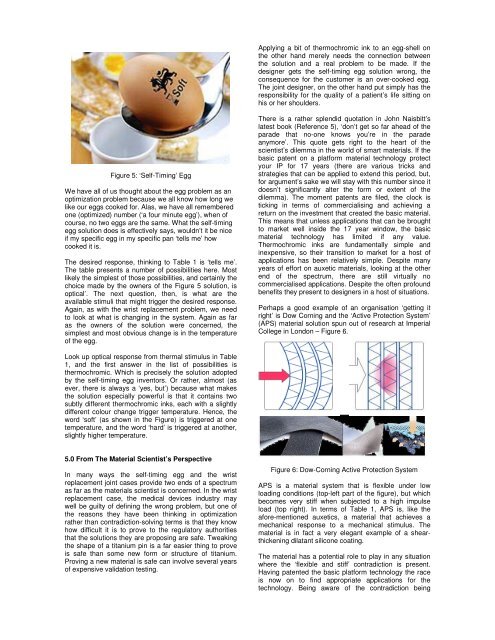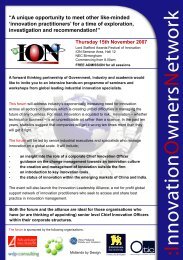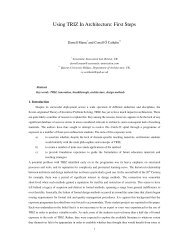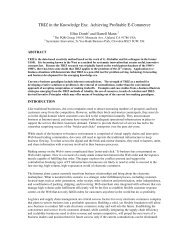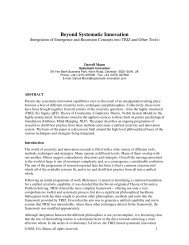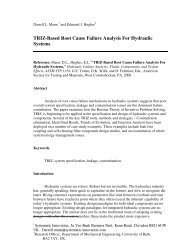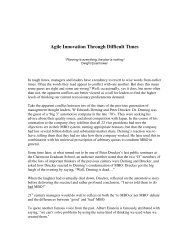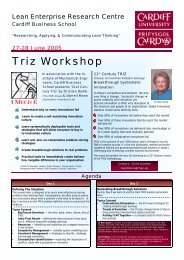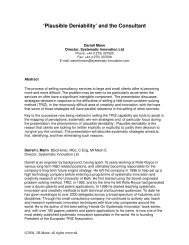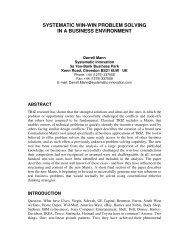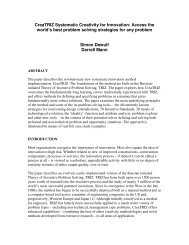Smart Materials Solve Contradictions - Systematic Innovation
Smart Materials Solve Contradictions - Systematic Innovation
Smart Materials Solve Contradictions - Systematic Innovation
Create successful ePaper yourself
Turn your PDF publications into a flip-book with our unique Google optimized e-Paper software.
Applying a bit of thermochromic ink to an egg-shell on<br />
the other hand merely needs the connection between<br />
the solution and a real problem to be made. If the<br />
designer gets the self-timing egg solution wrong, the<br />
consequence for the customer is an over-cooked egg.<br />
The joint designer, on the other hand put simply has the<br />
responsibility for the quality of a patient’s life sitting on<br />
his or her shoulders.<br />
Figure 5: ‘Self-Timing’ Egg<br />
We have all of us thought about the egg problem as an<br />
optimization problem because we all know how long we<br />
like our eggs cooked for. Alas, we have all remembered<br />
one (optimized) number (‘a four minute egg’), when of<br />
course, no two eggs are the same. What the self-timing<br />
egg solution does is effectively says, wouldn’t it be nice<br />
if my specific egg in my specific pan ‘tells me’ how<br />
cooked it is.<br />
The desired response, thinking to Table 1 is ‘tells me’.<br />
The table presents a number of possibilities here. Most<br />
likely the simplest of those possibilities, and certainly the<br />
choice made by the owners of the Figure 5 solution, is<br />
optical’. The next question, then, is what are the<br />
available stimuli that might trigger the desired response.<br />
Again, as with the wrist replacement problem, we need<br />
to look at what is changing in the system. Again as far<br />
as the owners of the solution were concerned, the<br />
simplest and most obvious change is in the temperature<br />
of the egg.<br />
There is a rather splendid quotation in John Naisbitt’s<br />
latest book (Reference 5), ‘don’t get so far ahead of the<br />
parade that no-one knows you’re in the parade<br />
anymore’. This quote gets right to the heart of the<br />
scientist’s dilemma in the world of smart materials. If the<br />
basic patent on a platform material technology protect<br />
your IP for 17 years (there are various tricks and<br />
strategies that can be applied to extend this period, but,<br />
for argument’s sake we will stay with this number since it<br />
doesn’t significantly alter the form or extent of the<br />
dilemma). The moment patents are filed, the clock is<br />
ticking in terms of commercialising and achieving a<br />
return on the investment that created the basic material.<br />
This means that unless applications that can be brought<br />
to market well inside the 17 year window, the basic<br />
material technology has limited if any value.<br />
Thermochromic inks are fundamentally simple and<br />
inexpensive, so their transition to market for a host of<br />
applications has been relatively simple. Despite many<br />
years of effort on auxetic materials, looking at the other<br />
end of the spectrum, there are still virtually no<br />
commercialised applications. Despite the often profound<br />
benefits they present to designers in a host of situations.<br />
Perhaps a good example of an organisation ‘getting it<br />
right’ is Dow Corning and the ‘Active Protection System’<br />
(APS) material solution spun out of research at Imperial<br />
College in London – Figure 6.<br />
Look up optical response from thermal stimulus in Table<br />
1, and the first answer in the list of possibilities is<br />
thermochromic. Which is precisely the solution adopted<br />
by the self-timing egg inventors. Or rather, almost (as<br />
ever, there is always a ‘yes, but’) because what makes<br />
the solution especially powerful is that it contains two<br />
subtly different thermochromic inks, each with a slightly<br />
different colour change trigger temperature. Hence, the<br />
word ‘soft’ (as shown in the Figure) is triggered at one<br />
temperature, and the word ‘hard’ is triggered at another,<br />
slightly higher temperature.<br />
5.0 From The Material Scientist’s Perspective<br />
In many ways the self-timing egg and the wrist<br />
replacement joint cases provide two ends of a spectrum<br />
as far as the materials scientist is concerned. In the wrist<br />
replacement case, the medical devices industry may<br />
well be guilty of defining the wrong problem, but one of<br />
the reasons they have been thinking in optimization<br />
rather than contradiction-solving terms is that they know<br />
how difficult it is to prove to the regulatory authorities<br />
that the solutions they are proposing are safe. Tweaking<br />
the shape of a titanium pin is a far easier thing to prove<br />
is safe than some new form or structure of titanium.<br />
Proving a new material is safe can involve several years<br />
of expensive validation testing.<br />
Figure 6: Dow-Corning Active Protection System<br />
APS is a material system that is flexible under low<br />
loading conditions (top-left part of the figure), but which<br />
becomes very stiff when subjected to a high impulse<br />
load (top right). In terms of Table 1, APS is, like the<br />
afore-mentioned auxetics, a material that achieves a<br />
mechanical response to a mechanical stimulus. The<br />
material is in fact a very elegant example of a shearthickening<br />
dilatant silicone coating.<br />
The material has a potential role to play in any situation<br />
where the ‘flexible and stiff’ contradiction is present.<br />
Having patented the basic platform technology the race<br />
is now on to find appropriate applications for the<br />
technology. Being aware of the contradiction being


